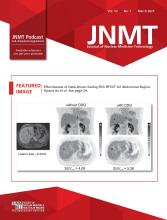Abstract
Mandibular condylar hyperplasia (CH) is a complex deformity originating from developmental asymmetries of the hyperplastic condyle. Bone scan single photon emission computed tomography (SPECT) is a sensitive and accurate method of detecting the growth activity of this disorder. This method can be used to quantitate the radio-nuclide uptake differences between the left and right condyles. Uptake differences of 10 or more percent between the left and right condyles, with increased uptake in the CH side, are considered to be evidence of active growing condylar hyperplasia. Quantitative assessment of the CH is important in order to choose an appropriate treatment course. Degenerative arthropathies of the temporomandibular joints (TMJs) may result in altered uptake, but this mostly is associated with the contralateral side of CH. The computed tomography (CT) modality available from SPECT/CT is useful to assess the condylar dimensions and underlying bony changes.







